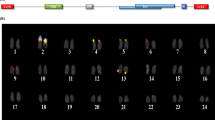Abstract
A consensus nucleotide sequence of long terminal repeats (LTRs) of endogenous human-specific retroviruses of the K family (HERV-K) was constructed and used for the genome-wide search for homologies in international databases. There were revealed 142 LTRs, 12 of which were localized in introns of unique human genes. It was found for the first time that ten intron LTRs are absent in the orthologic loci of the chimpanzee genome and the orientation of nine of them is opposite to the transcription direction of the corresponding human genes. A hypothesis was propounded that the found LTRs affect the gene expression by initiation of the antisense RNA synthesis.
Similar content being viewed by others
References
Duboule, D. and Wilkins, A.S., Trends Genet., 1998, vol. 14, pp. 54–59.
King, M.C. and Wilson, A.C., Science, 1975, vol. 188, pp. 107–116.
International Human Genome Sequencing Consortium, Nature, 2001, vol. 409, pp. 860–921.
Kazazian, H.H., Jr., Science, 2000, vol. 289, pp. 1152–1153.
Landry, J.R., Medstrand, P., and Mager, D.L., Genomics, 2001, vol. 76, pp. 110–116.
Brosius, J., Gene, 1999, vol. 238, pp. 115–134.
Medstrand, P., Landry, J.R., and Mager, D.L., J. Biol. Chem., 2001, vol. 276, pp. 1896–1903.
Sverdlov, E.D., Bioessays, 2000, vol. 22, pp. 161–171.
Boissinot, S., Chevret, P., and Furano, A.V., Mol. Biol. Evol., 2000, vol. 17, pp. 915–928.
Carroll, M.L., Roy-Engel, A.M., Nguyen, S.V., Salem, A.H., Vogel, E., Vincent, B., Myers, J., Ahmad, Z., Nguyen, L., Sammarco, M., Watkins, W.S., Henke, J., Makalowski, W., Jorde, L.B., Deininger, P.L., and Batzer, M.A., J. Mol. Biol., 2001, vol. 311, pp. 17–40.
Medstrand, P. and Mager, D.L., J. Virol., 1998, vol. 72, pp. 9782–9787.
Lebedev, Y.B., Belonovitch, O.S., Zybrova, N.V., Khil, P.P., Kurdyukov, S.G., Vinogradova, T.V., Hunsmann, G., and Sverdlov, E.D., Gene, 2000, vol. 247, pp. 265–277.
Buzdin, A., Khodosevich, K., Mamedov, I., Vinogradova, T., Lebedev, Y., Hunsmann, G., and Sverdlov, E., Genomics, 2002, vol. 79, pp. 413–422.
Barbulescu, M., Turner, G., Seaman, M.I., Deinard, A.S., Kidd, K.K., and Lenz, J., Curr. Biol., 1999, vol. 9, pp. 861–868.
Sverdlov, E.D., Bioorg. Khim., 2001, vol. 27, pp. 237–240.
Lynch, M. and Conery, J.S., Science, 2000, vol. 290, pp. 1151–1155.
Vinogradova, T.V., Leppik, L.P., Nikolaev, L.G., Akopov, S.B., Kleiman, A.M., Senyuta, N.B., and Sverdlov, E.D., Virology, 2001, vol. 290, pp. 83–90.
Lower, R., Trends Microbiol., 1999, vol. 7, pp. 350–356.
Domansky, A.N., Kopantzev, E.P., Snezhkov, E.V., Lebedev, Y.B., Leib-Mosch, C., and Sverdlov, E.D., FEBS Lett., 2000, vol. 472, pp. 191–195.
Lum, L.S., Sutzman, L.A., Kaufman, R.J., Linzer, D.I., and Wu, B.J., Mol. Cell. Biol., 1990, vol. 10, pp. 6709–6717.
Dangel, A.W., Mendoza, A.R., Baker, B.J., Daniel, C.M., Carrol, M.C., Wu, L.C., and Yu, C.Y., Immunogenetics, 1994, vol. 40, pp. 425–436.
Schneider, P.M., Witzel-Schlomp, K., Rttner, C., and Zhang, L., Immunogenetics, 2001, vol. 53, pp. 1–9.
Author information
Authors and Affiliations
Corresponding author
Rights and permissions
About this article
Cite this article
Buzdin, A.A., Lebedev, Y.B. & Sverdlov, E.D. Human-Specific HERV-K Intron LTRs Have Nonaccidental Opposite Orientation Relative to the Direction of Gene Transcription and Might Be Involved in the Antisense Regulation of Gene Expression. Russian Journal of Bioorganic Chemistry 29, 91–93 (2003). https://doi.org/10.1023/A:1022294906202
Issue Date:
DOI: https://doi.org/10.1023/A:1022294906202




